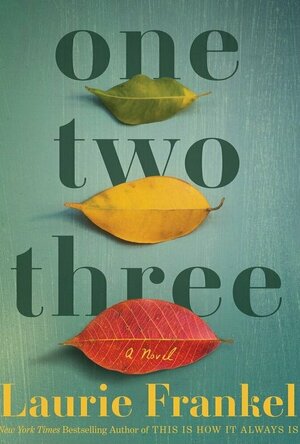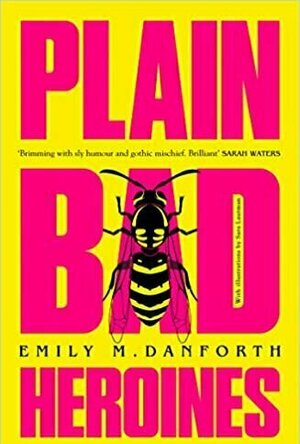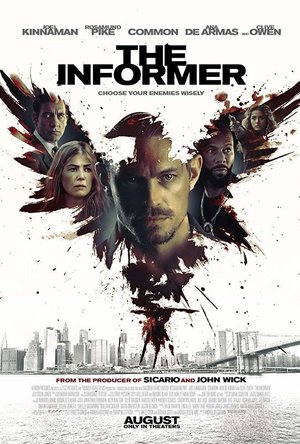Search
Search results
Kristy H (1252 KP) rated One Two Three in Books
Jun 10, 2021
A touching read about family and resilience
Nothing new ever happens in the town of Bourne. Everyone knows everyone. So when the moving trucks arrive, it causes a stir. Bourne is a town known for one thing: seventeen years ago, their water turned green. Many of their citizens of died, others have cancer and other illnesses, and others gave birth to children with birth defects. You'll never find a town more accommodating to wheelchairs. But it has one doctor (also the priest) and one therapist (Nora Mitchell). Bourne houses Nora's triplets, beloved by all: Mab, the "normal" one, who is expected to go to college and escape this place; Monday, who runs the town library from their home and prefers yellow everything (food, clothes, and more); and Mirabel, the smartest of them all, confined to her wheelchair, dependent on her sisters and mom for so much and on a computer to act as her Voice. Nora has been fighting for justice since the water turned green. When the newcomers come to town, the past roars up, involving the Mitchell triplets and bringing to light decades old secrets. How hard will Mab, Monday, and Mirabel fight for their town?
This is such an original book from the author of THIS IS HOW IT ALWAYS IS. It sneaks up on you with its quiet and touching story. Frankel weaves an emotional tale that makes you think. It's utterly fascinating, this devastated town and its broken people. So many of its citizens are sick or have lost someone they love. Yet there is a lot of hope in Bourne, especially as the story is told through young Mab, Monday, and Mirabel's eyes. They've only known their mom's sadness and bitterness, never having met their father, yet each has their own (often quirky) way of looking at life.
Frankel alternates viewpoints from each triplet, naming her chapters One (Mab), Two (Monday), and Three (Mirabel) and repeating from there. It takes a moment to get into the groove of each triplets' voice, but once you do, it's easy to get attached to them. Mab feels the weight of the world on her shoulders, sweet Monday takes everything literally, and Mirabel must remain cheerful, despite all her medical issues. Their mom holds a variety of jobs, including town therapist and working at the local bar, and maintains a decades long lawsuit and grievance. It's hard to know what the triplets' life might be like without Nora's anger and bitterness.
Still, ONE TWO THREE highlights the power of sisterhood and family. You'd think a book about a broken town would be depressing and a slugfest, but it's anything but. In many ways, I found this to be almost a mystery, as the sisters work together to figure out about the newcomers in their town and how they relate to the years of devastation wrecked upon Bourne. The result is utterly compelling, with years of intertwined secrets making for a fascinating read.
Still, at the core, this is a story about teenage girls and how they relate to the world. It's sweet, heartbreaking, and extremely well-written. There are a few points where I wish the plot sped up a bit, but overall, this is a touching and lovely story about a family and their small town.
I received a copy of this book from Henry Holt & Company and Netgalley in return for an unbiased review. Look for ONE TWO THREE on 6/8/2021!
This is such an original book from the author of THIS IS HOW IT ALWAYS IS. It sneaks up on you with its quiet and touching story. Frankel weaves an emotional tale that makes you think. It's utterly fascinating, this devastated town and its broken people. So many of its citizens are sick or have lost someone they love. Yet there is a lot of hope in Bourne, especially as the story is told through young Mab, Monday, and Mirabel's eyes. They've only known their mom's sadness and bitterness, never having met their father, yet each has their own (often quirky) way of looking at life.
Frankel alternates viewpoints from each triplet, naming her chapters One (Mab), Two (Monday), and Three (Mirabel) and repeating from there. It takes a moment to get into the groove of each triplets' voice, but once you do, it's easy to get attached to them. Mab feels the weight of the world on her shoulders, sweet Monday takes everything literally, and Mirabel must remain cheerful, despite all her medical issues. Their mom holds a variety of jobs, including town therapist and working at the local bar, and maintains a decades long lawsuit and grievance. It's hard to know what the triplets' life might be like without Nora's anger and bitterness.
Still, ONE TWO THREE highlights the power of sisterhood and family. You'd think a book about a broken town would be depressing and a slugfest, but it's anything but. In many ways, I found this to be almost a mystery, as the sisters work together to figure out about the newcomers in their town and how they relate to the years of devastation wrecked upon Bourne. The result is utterly compelling, with years of intertwined secrets making for a fascinating read.
Still, at the core, this is a story about teenage girls and how they relate to the world. It's sweet, heartbreaking, and extremely well-written. There are a few points where I wish the plot sped up a bit, but overall, this is a touching and lovely story about a family and their small town.
I received a copy of this book from Henry Holt & Company and Netgalley in return for an unbiased review. Look for ONE TWO THREE on 6/8/2021!
Kristy H (1252 KP) rated That Summer in Books
May 27, 2021
A touching and insightful look into the power of the past
On the surface, Daisy Shoemaker has the perfect life: a doting lawyer husband, a loving daughter, and her own cooking business. But underneath, she's full of doubts. Her husband is distant, her teenage daughter resentful, and her business--just something to keep her "occupied." Daisy's been receiving emails lately, meant for another woman named Diana, Daisy's given name. This Diana, a business consultant, seems glamorous and wealthy. When Diana invites Daisy to lunch, she impulsively says yes. But as the two form a friendship, Daisy starts to wonder if their connection was purely accidental. What exactly does Diana want from Daisy?
"For the last six months, Daisy had been receiving emails that she realized were intended not for her, but for the other Diana."
This is not a light and airy beach read, but a serious book that focuses in on the recent #MeToo topic. Much of the book doesn't even take place on the promised Cape setting. Does that mean it's not worth a read? Not at all. Weiner's constructed a compelling and heartfelt tale, with characters that pull you into the story. It feels a little reminiscent of some other #MeToo stories I've read recently, but I was still glued to the pages, wondering what had happened in Diana's past and how things would turn out for everyone.
There's a bit of a mystery here, but it's not too hard to figure out how everything pieces together. The real focus is the characters. We have Daisy, insecure and struggling in her marriage to Hal, a wealthy and arrogant man more than a decade older than her. It's clear Hal takes Daisy for granted--and that may be letting him off easy. Their daughter, Beatrice, was a favorite of mine: an original teen, with her own unique way of living her life. Beatrice's scenes stood out; she's a character I won't soon easily forget. We also have Daisy's brother, Danny, and his husband Jesse. And then there's the "other" Diana, who worms her way into Daisy's life. Can we trust her? Diana was a memorable character to me as well, along with someone close to her. (I don't want to say much more for spoilers.)
The book is told mainly from Daisy, Diana, and Beatrice's perspectives. It goes back and forth in time. It's a little confusing in the beginning, getting the timeline straight and how all the characters relate. Once I got that down, it was a fast read. Some of it may be a little predictable, but it's in turns sad, heartwarming, and funny. I loved Beatrice, as mentioned, and the dynamic between Daisy and Diana was well-written. Weiner does a good job of exploring how class and privilege relate to sexual assault (a definite trigger warning for rape in this story) and the repercussions of rape across individuals, families, and friends. She focuses, too, on the importance of accepting those you love for who they are, no strings attached.
Overall, I'm quite glad I picked this one up. Despite some of the vague familiarity to other #MeToo books, for the most part, it felt refreshing and interesting. It certainly held my attention and brought to light the important topic of rape and its aftermath. The characters here are well-drawn, and I'll always have a place in my heart for dear Beatrice. 4 stars.
"For the last six months, Daisy had been receiving emails that she realized were intended not for her, but for the other Diana."
This is not a light and airy beach read, but a serious book that focuses in on the recent #MeToo topic. Much of the book doesn't even take place on the promised Cape setting. Does that mean it's not worth a read? Not at all. Weiner's constructed a compelling and heartfelt tale, with characters that pull you into the story. It feels a little reminiscent of some other #MeToo stories I've read recently, but I was still glued to the pages, wondering what had happened in Diana's past and how things would turn out for everyone.
There's a bit of a mystery here, but it's not too hard to figure out how everything pieces together. The real focus is the characters. We have Daisy, insecure and struggling in her marriage to Hal, a wealthy and arrogant man more than a decade older than her. It's clear Hal takes Daisy for granted--and that may be letting him off easy. Their daughter, Beatrice, was a favorite of mine: an original teen, with her own unique way of living her life. Beatrice's scenes stood out; she's a character I won't soon easily forget. We also have Daisy's brother, Danny, and his husband Jesse. And then there's the "other" Diana, who worms her way into Daisy's life. Can we trust her? Diana was a memorable character to me as well, along with someone close to her. (I don't want to say much more for spoilers.)
The book is told mainly from Daisy, Diana, and Beatrice's perspectives. It goes back and forth in time. It's a little confusing in the beginning, getting the timeline straight and how all the characters relate. Once I got that down, it was a fast read. Some of it may be a little predictable, but it's in turns sad, heartwarming, and funny. I loved Beatrice, as mentioned, and the dynamic between Daisy and Diana was well-written. Weiner does a good job of exploring how class and privilege relate to sexual assault (a definite trigger warning for rape in this story) and the repercussions of rape across individuals, families, and friends. She focuses, too, on the importance of accepting those you love for who they are, no strings attached.
Overall, I'm quite glad I picked this one up. Despite some of the vague familiarity to other #MeToo books, for the most part, it felt refreshing and interesting. It certainly held my attention and brought to light the important topic of rape and its aftermath. The characters here are well-drawn, and I'll always have a place in my heart for dear Beatrice. 4 stars.
Charlie Cobra Reviews (1840 KP) rated Cruella (2021) in Movies
Jun 2, 2021 (Updated Jun 3, 2021)
The Acting- great performances by both Emma Stone and Emma Thompson (2 more)
The costume designs and wardrobe were amazing to see
The soundtrack was phenomenal - great music
Original cartoon Cruella vs this Cruella (1 more)
The pacing was sparratic and movie ran a little too long
Part Devil Wears Prada, Part The Joker, Surprisingly Splendid
https://youtu.be/Ja_Cl-9IKNI
I have to say this movie really wasn't on the top of my list for "must watch" movies as much as I like Disney movies and Emma Stone as an actress (loved her in Superbad as Jules, lol) but I really liked this movie and it was really good. Emma Stone was fantastic as Estella/Cruella and this movie really came off as a mix of Devil Wears Prada and The Joker in my opinion. I wasn't sure if I was going to like it in the beginning because I was weary of the concept of them trying to turn this villain into a good guy or giving them a compelling reason for their "villainy" ways but I'm a sucker for revenge movies. I have to say it had me right away with what happens to her mother and It was "hook, line and sinker" for me and I was along for the ride. I like how the movie kept the characters of Jasper and Horace which if I remember correctly were the name of her two helpers the skinny and fat one from the cartoons who helped her steal all those puppies so that was pretty cool as well. I really can't say how much I loved the soundtrack for this movie, it was just hit after hit, song after song the whole way through the film. Lots of great oldie music from around the times that they movie was supposed to be set in which was 1970's. There were some issues that I had with the movie like how it portrays Cruella when she's so horrible in the cartoons, how the plot turns into a whole heist situation, and how it takes until the end of the movie to answer a lot of the questions that were building up the whole movie. The movie did have good things too, such as the acting being great, especially the performances by Emma Stone and Emma Thompson, the setting and time period fitting the story in 1970's London and the clothes and the fashion, not to mention the soundtrack that knocked it out of the park. I give this movie a 7/10, unfortunately it doesn't get my "must see" seal of approval and I wouldn't suggest shelling out $30 on top of your Disney Plus subscription to see this movie by yourself. However, if you plan on watching as a family it is definitely worth it to watch it in the comfort of your own home and not worry about movie theater etiquette or prices especially if you have young ones. If your not in a rush to watch it, I would wait until it becomes free to watch on Disney Plus which has been announced as Friday August 27th, so around 3 months. If you want to hear more of what I thought about the movie stick around for the spoiler section review.
-------------------------------------------------------
Spoiler Section Review:
https://youtu.be/PvPC_yAMwFQ
I guess my spoiler section review ran a little long so if your interested in what else I had to say check out the full review on my website or check out my spoiler section video on YouTube.
I have to say this movie really wasn't on the top of my list for "must watch" movies as much as I like Disney movies and Emma Stone as an actress (loved her in Superbad as Jules, lol) but I really liked this movie and it was really good. Emma Stone was fantastic as Estella/Cruella and this movie really came off as a mix of Devil Wears Prada and The Joker in my opinion. I wasn't sure if I was going to like it in the beginning because I was weary of the concept of them trying to turn this villain into a good guy or giving them a compelling reason for their "villainy" ways but I'm a sucker for revenge movies. I have to say it had me right away with what happens to her mother and It was "hook, line and sinker" for me and I was along for the ride. I like how the movie kept the characters of Jasper and Horace which if I remember correctly were the name of her two helpers the skinny and fat one from the cartoons who helped her steal all those puppies so that was pretty cool as well. I really can't say how much I loved the soundtrack for this movie, it was just hit after hit, song after song the whole way through the film. Lots of great oldie music from around the times that they movie was supposed to be set in which was 1970's. There were some issues that I had with the movie like how it portrays Cruella when she's so horrible in the cartoons, how the plot turns into a whole heist situation, and how it takes until the end of the movie to answer a lot of the questions that were building up the whole movie. The movie did have good things too, such as the acting being great, especially the performances by Emma Stone and Emma Thompson, the setting and time period fitting the story in 1970's London and the clothes and the fashion, not to mention the soundtrack that knocked it out of the park. I give this movie a 7/10, unfortunately it doesn't get my "must see" seal of approval and I wouldn't suggest shelling out $30 on top of your Disney Plus subscription to see this movie by yourself. However, if you plan on watching as a family it is definitely worth it to watch it in the comfort of your own home and not worry about movie theater etiquette or prices especially if you have young ones. If your not in a rush to watch it, I would wait until it becomes free to watch on Disney Plus which has been announced as Friday August 27th, so around 3 months. If you want to hear more of what I thought about the movie stick around for the spoiler section review.
-------------------------------------------------------
Spoiler Section Review:
https://youtu.be/PvPC_yAMwFQ
I guess my spoiler section review ran a little long so if your interested in what else I had to say check out the full review on my website or check out my spoiler section video on YouTube.
Kristy H (1252 KP) rated Plain Bad Heroines in Books
Dec 17, 2020
Plain Bad Heroines was one of my most anticipated reads of the year. I am a sucker for a lesbian tale. Add in a Gothic New England boarding school for girls? Sold.
The story centers around two time periods. The first, 1902, at the Brookhants School for Girls, run by Libbie Brookhants. A book by a young writer, Mary MacLane has come out--one that's incredibly scandalous for the times. Two Brookhants girls, Flo and Clara, are obsessed with it and establish The Plain Bad Heroine Society. The two are in love, meeting in secret--until they are attacked by yellow jackets at their hiding spot, a copy of the book found with them. A few years later the school closes, but not until after more scandal and death. Now, our second period, over a hundred years later, where Merritt Emmons, a young writer, publishes a book about Flo and Clara's story. It inspires a horror film starring Harper Harper, a famous lesbian actress. Harper will be playing Flo and B-list actress Audrey Wells, Clara. Filming on-site at the abandoned Brookhants site, the three women converge. But soon, weird things start happening, and the curse of Brookhants seems back to haunt the set--and our three modern-day heroines.
This book is absolutely enthralling at times. I flew through these 619 pages, that's for sure. My notes state "very lesbian," which is, of course, a major plus for me. Believe me, we don't get a lot of books starring ourselves. And you know, where we are killed off by swarms of yellow jackets. I honestly found both storylines compelling. It's hard not to fall a bit in love with Harper Harper, the charismatic celebrity (out!) lesbian. And 1902 isn't just about Clara and Flo, but Libbie Brookhants and her life trying to run a cursed school in the early 1900s. Honestly, the pages really flew by most of the time. Though, there are certainly moments where I felt some of the story could have been cut.
And yes, the narrative style is different, though it really adds to the uniqueness of the book. It's basically told by an omnipresent narrator, talking directly to the reader. There are footnotes, often humorous ones, and the end result is something you don't often find. For the most part, I felt like Danforth pulled it off, too. I do think Libbie was a little more fully developed than Merritt, Harper, and Audrey, but that also may have been because that trio could come across as a bit spoiled at times.
Probably my two biggest issues with this book (regretfully): for a Gothic horror novel, it's not really that scary. There are a few creepy and eerie moments, especially in the beginning, but it never really builds up to that terrifying moment that you're expecting. And, somewhat related, the ending. We read and stick with our various tales for the entire time and then... poof! Everything just fizzles out. I was so bummed. The ending was such a disappointment after all I'd read and kept this from being a full-fledged 4 or 4.5-star read. I couldn't believe it after what we'd been through. It was like even the author was tired.
So, overall, this is an original and fascinating read. I'm certainly still advising you to read it (especially if you're queer or enjoy reading queer fiction). Just be prepared that the ending may not have that big scary moment you're expecting. 3.5 stars.
The story centers around two time periods. The first, 1902, at the Brookhants School for Girls, run by Libbie Brookhants. A book by a young writer, Mary MacLane has come out--one that's incredibly scandalous for the times. Two Brookhants girls, Flo and Clara, are obsessed with it and establish The Plain Bad Heroine Society. The two are in love, meeting in secret--until they are attacked by yellow jackets at their hiding spot, a copy of the book found with them. A few years later the school closes, but not until after more scandal and death. Now, our second period, over a hundred years later, where Merritt Emmons, a young writer, publishes a book about Flo and Clara's story. It inspires a horror film starring Harper Harper, a famous lesbian actress. Harper will be playing Flo and B-list actress Audrey Wells, Clara. Filming on-site at the abandoned Brookhants site, the three women converge. But soon, weird things start happening, and the curse of Brookhants seems back to haunt the set--and our three modern-day heroines.
This book is absolutely enthralling at times. I flew through these 619 pages, that's for sure. My notes state "very lesbian," which is, of course, a major plus for me. Believe me, we don't get a lot of books starring ourselves. And you know, where we are killed off by swarms of yellow jackets. I honestly found both storylines compelling. It's hard not to fall a bit in love with Harper Harper, the charismatic celebrity (out!) lesbian. And 1902 isn't just about Clara and Flo, but Libbie Brookhants and her life trying to run a cursed school in the early 1900s. Honestly, the pages really flew by most of the time. Though, there are certainly moments where I felt some of the story could have been cut.
And yes, the narrative style is different, though it really adds to the uniqueness of the book. It's basically told by an omnipresent narrator, talking directly to the reader. There are footnotes, often humorous ones, and the end result is something you don't often find. For the most part, I felt like Danforth pulled it off, too. I do think Libbie was a little more fully developed than Merritt, Harper, and Audrey, but that also may have been because that trio could come across as a bit spoiled at times.
Probably my two biggest issues with this book (regretfully): for a Gothic horror novel, it's not really that scary. There are a few creepy and eerie moments, especially in the beginning, but it never really builds up to that terrifying moment that you're expecting. And, somewhat related, the ending. We read and stick with our various tales for the entire time and then... poof! Everything just fizzles out. I was so bummed. The ending was such a disappointment after all I'd read and kept this from being a full-fledged 4 or 4.5-star read. I couldn't believe it after what we'd been through. It was like even the author was tired.
So, overall, this is an original and fascinating read. I'm certainly still advising you to read it (especially if you're queer or enjoy reading queer fiction). Just be prepared that the ending may not have that big scary moment you're expecting. 3.5 stars.
Gareth von Kallenbach (980 KP) rated The Wall (2017) in Movies
Jul 11, 2019
US Ranger Sniper, Staff Sargent Shane Matthews (John Cena), and his spotter, Sargent Allen “Eyes” Isaac, are investigating a distress call in the hot Iraqi desert above an oil pipeline construction area. From their camouflaged position they can see several dead bodies. They have waited close to 18 hours while sitting and observing the bodies and landscape, trying to determine what happened. Matthews decides the dead men below them must have been killed by a raid and after the hours of waiting he leaves the covered position to investigate up close. While Isaac believes that there is a chance this could be the work of a skilled sniper, he reluctantly agrees to let Matthews go.
As Isaac watches from cover Mathews surveys the carnage from up close and quickly realizes that Isaac must have been right. All of the men below were killed with skilled shots to the head. Before he can find cover or find where the shooter was positioned Mathews is shot in the stomach and falls to the ground. Isaac rushes to his aide but as soon as he gets close to his comrade he is shot in the knee. As shots rain down on him Isaac dives for cover behind a dilapidated wall. Now he is stuck behind fragile cover bleeding with his partner unable to move due to his wounds. Isaac scrabbles to radio for help but he only finds his radio antenna has been shot off. He has no idea where the shots came from only that he may be in the only safe place. Isaac is now suck behind a wall with no way to get to his severely wounded friend or call in reinforcements. Then over his short range two-way radio a voice can be heard and it’s not Matthews or help…it’s the enemy sniper.
The Wall is a suspense film directed by Doug Liman (Edge of Tomorrow, Fair Game and Mr. and Mrs. Smith). Overall the small cast gave good performances. I thought that John Cena did a good job in a limited role in this film. Aaron Taylor-Johnson did an adequate job, but since he was on screen by himself for the majority of the film I thought his performance was at times week. He was also really compelling at times which is why I think overall it was adequate. I think it was a good story but the build up to the end lacked the true suspense that could have made it a great story. I just didn’t have the ending that really made me sit on the edge of my seat. It felt like what was happening was inevitable. I commend the originality of the overall story. But when I am going to watch a suspenseful film I want just a little bit more. To me it lacked an edge and really captivating moment at the end. One of the things the film got right was how realistic it felt. The cinematography was gritty and fit the story really well.
Overall I came out of this film feeling good but thought that it was missing a little something. Worth a second viewing sometime in the future but probably save it for video or on demand.
As Isaac watches from cover Mathews surveys the carnage from up close and quickly realizes that Isaac must have been right. All of the men below were killed with skilled shots to the head. Before he can find cover or find where the shooter was positioned Mathews is shot in the stomach and falls to the ground. Isaac rushes to his aide but as soon as he gets close to his comrade he is shot in the knee. As shots rain down on him Isaac dives for cover behind a dilapidated wall. Now he is stuck behind fragile cover bleeding with his partner unable to move due to his wounds. Isaac scrabbles to radio for help but he only finds his radio antenna has been shot off. He has no idea where the shots came from only that he may be in the only safe place. Isaac is now suck behind a wall with no way to get to his severely wounded friend or call in reinforcements. Then over his short range two-way radio a voice can be heard and it’s not Matthews or help…it’s the enemy sniper.
The Wall is a suspense film directed by Doug Liman (Edge of Tomorrow, Fair Game and Mr. and Mrs. Smith). Overall the small cast gave good performances. I thought that John Cena did a good job in a limited role in this film. Aaron Taylor-Johnson did an adequate job, but since he was on screen by himself for the majority of the film I thought his performance was at times week. He was also really compelling at times which is why I think overall it was adequate. I think it was a good story but the build up to the end lacked the true suspense that could have made it a great story. I just didn’t have the ending that really made me sit on the edge of my seat. It felt like what was happening was inevitable. I commend the originality of the overall story. But when I am going to watch a suspenseful film I want just a little bit more. To me it lacked an edge and really captivating moment at the end. One of the things the film got right was how realistic it felt. The cinematography was gritty and fit the story really well.
Overall I came out of this film feeling good but thought that it was missing a little something. Worth a second viewing sometime in the future but probably save it for video or on demand.
Gareth von Kallenbach (980 KP) rated Passengers (2016) in Movies
Jul 12, 2019
Jim Preston (Chris Pratt) is a man looking for a fresh start on a new world. Along with 5000 other passengers; Jim is sleeping away the 120 year journey in stasis aboard a luxury ship. In the new film “Passengers”, Jim finds his entire world turned upside down when he is awakened 90 years before the completion of his trip. Alone with no way to return to stasis; Jim struggles to keep his wits as despite having food and recreation readily available, his only companions are server robots and an Android bartender named Arthur (Michael Sheen).
Unable to wake any of the crew to assist him with the situation or access the bridge of the ship, Jim uses his engineering skills to study the operations of the ship as well as gain access to areas normally reserved for VIP passengers.
As time goes by Jim becomes more and more despondent because he cannot even contact anyone on earth as the computer informs him that it will take 36 years for reply to any of his messages to reach the ship and he grows weary of the thought of spending the rest of his life alone.
During one of his frequent visits to his former stasis chamber, Jim discovers an attractive passenger named Aurora (Jennifer Lawrence), and using the ships database, proceeds to learn all about her and begins to fall in love with her as she sleeps blissfully unaware of his presence.
Fate eventually gets in the way and Aurora awakens and joins Jim is the only people awake on the massive ship. Having come from a privileged background as a successful author, Aurora is really upset over spending the rest of her life on the ship as her plan was to spend a year on the colony world before returning to Earth and resuming her writing career 241 years after she left with the adventure she is undertaken being the basis for some of her new work.
The two eventually have feelings for one another, but Jim is harboring a dark secret that threatens to unravel the happy life they have been able to build for one another. As if that was not enough, the ship is experiencing random and increasing malfunctions which threaten not only their survival, but the long-term survival of the fellow crew and passengers and the long journey that they have ahead of them.
What follows is a time predictable but albeit entertaining mix of romance and action. There are some very good visuals in the film and while the story moves along at a very predictable pace, the two leads make the material work. The film does have numerous plot holes in it which I cannot go into without spoiling it but suffice it to say the premise of q couple stranded is not new.
Yes we have seen this all before but the cast and the interesting locale and visuals make the film add up to more than the sum of its parts. I only wish there’d been a little more time shoring up the plot holes and perhaps adding a little bit of mystery and intrigue to the plot as it truly would’ve made this more compelling.
Unable to wake any of the crew to assist him with the situation or access the bridge of the ship, Jim uses his engineering skills to study the operations of the ship as well as gain access to areas normally reserved for VIP passengers.
As time goes by Jim becomes more and more despondent because he cannot even contact anyone on earth as the computer informs him that it will take 36 years for reply to any of his messages to reach the ship and he grows weary of the thought of spending the rest of his life alone.
During one of his frequent visits to his former stasis chamber, Jim discovers an attractive passenger named Aurora (Jennifer Lawrence), and using the ships database, proceeds to learn all about her and begins to fall in love with her as she sleeps blissfully unaware of his presence.
Fate eventually gets in the way and Aurora awakens and joins Jim is the only people awake on the massive ship. Having come from a privileged background as a successful author, Aurora is really upset over spending the rest of her life on the ship as her plan was to spend a year on the colony world before returning to Earth and resuming her writing career 241 years after she left with the adventure she is undertaken being the basis for some of her new work.
The two eventually have feelings for one another, but Jim is harboring a dark secret that threatens to unravel the happy life they have been able to build for one another. As if that was not enough, the ship is experiencing random and increasing malfunctions which threaten not only their survival, but the long-term survival of the fellow crew and passengers and the long journey that they have ahead of them.
What follows is a time predictable but albeit entertaining mix of romance and action. There are some very good visuals in the film and while the story moves along at a very predictable pace, the two leads make the material work. The film does have numerous plot holes in it which I cannot go into without spoiling it but suffice it to say the premise of q couple stranded is not new.
Yes we have seen this all before but the cast and the interesting locale and visuals make the film add up to more than the sum of its parts. I only wish there’d been a little more time shoring up the plot holes and perhaps adding a little bit of mystery and intrigue to the plot as it truly would’ve made this more compelling.
James P. Sumner (65 KP) rated The Informer (2019) in Movies
Sep 10, 2019
A real hidden gem.
I went into this film knowing very little about it, other than the two-line blurb on my local cinema's website. Released to a muted fanfare, this twisty-turny crime drama is a surprisingly gripping and taut thriller, with some stand-out performances from the cast.
Joel Kinnaman plays Pete Koslow, an ex-con that we soon discover is working undercover for the FBI to help take down a mob boss in New York City. Not much is known (or, frustratingly, revealed) about Koslow's backstory, but Kinnaman plays the part very well. It's not as in-depth as maybe it could've been, but his personal arc is a fresh and original spin on a tried-and-tested formula, and it is, at times, compelling to watch.
Needless to say, Koslow's arrangement with the FBI goes sour before too long, and he's left alone in prison with multiple groups of enemies with their own agendas trying to kill him. The second half of the film, where the twists and turns and clever plotting flows more freely, reminded me of Will Smith's "Enemy of the State" and Liam Neeson's "A Walk Among The Tombstones", in terms of the complex approach and execution to resolving a seemingly inescapable situation.
The story was told to great effect, with the gritty tone and the deliberate pacing perfectly suiting this competent thriller.
Ana de Armas is terrific as Koslow's long-suffering and admiringly-loyal partner, Sofia. She has a look of naivety and innocence throughout, with her perma-watering wide eyes and youthful good looks, yet she is as tough as they come and the perfect match for Kinnaman's lead.
Clive Owen also deserves a mention for another consistent performance, despite him being woefully underused here. He steals every scene he's in, playing a menacing background antagonist incredibly well.
For me, this movie was let down by two things. First, its ending, which felt sudden and rushed, as if it stopped mid-sentence. It's not the kind of film that warrants a sequel, nor was it, I imagine, made with the intention of one. So to leave so many questions unanswered serves little purpose and ultimately leaves you disappointed after what was otherwise a very, very clever film.
Secondly, Rosamund Pike's performance left a lot to be desired. Because of her outstanding lack of on-screen charisma, you never truly connect with her character, Agent Wilcox. Her handling of Koslow's operation felt hollow. She showed no emotional range whatsoever, and wore the same expression throughout the entire film. Consequently, the journey of her character and the impact her decisions have on both other people, and the movie's eventual outcome, felt empty and pointless.
Despite that, this is a real hidden gem. As I noted earlier, this wasn't what you would call a "big" release. It came out under the radar and, as a result, was the subject of very few expectations. But what you have here is an intelligent thriller that provides an original take on a typical storyline that delivers in almost every way it intended to.
This is the film you stream off Netflix on a Friday night while eating a takeaway after a hard week at work.
Joel Kinnaman plays Pete Koslow, an ex-con that we soon discover is working undercover for the FBI to help take down a mob boss in New York City. Not much is known (or, frustratingly, revealed) about Koslow's backstory, but Kinnaman plays the part very well. It's not as in-depth as maybe it could've been, but his personal arc is a fresh and original spin on a tried-and-tested formula, and it is, at times, compelling to watch.
Needless to say, Koslow's arrangement with the FBI goes sour before too long, and he's left alone in prison with multiple groups of enemies with their own agendas trying to kill him. The second half of the film, where the twists and turns and clever plotting flows more freely, reminded me of Will Smith's "Enemy of the State" and Liam Neeson's "A Walk Among The Tombstones", in terms of the complex approach and execution to resolving a seemingly inescapable situation.
The story was told to great effect, with the gritty tone and the deliberate pacing perfectly suiting this competent thriller.
Ana de Armas is terrific as Koslow's long-suffering and admiringly-loyal partner, Sofia. She has a look of naivety and innocence throughout, with her perma-watering wide eyes and youthful good looks, yet she is as tough as they come and the perfect match for Kinnaman's lead.
Clive Owen also deserves a mention for another consistent performance, despite him being woefully underused here. He steals every scene he's in, playing a menacing background antagonist incredibly well.
For me, this movie was let down by two things. First, its ending, which felt sudden and rushed, as if it stopped mid-sentence. It's not the kind of film that warrants a sequel, nor was it, I imagine, made with the intention of one. So to leave so many questions unanswered serves little purpose and ultimately leaves you disappointed after what was otherwise a very, very clever film.
Secondly, Rosamund Pike's performance left a lot to be desired. Because of her outstanding lack of on-screen charisma, you never truly connect with her character, Agent Wilcox. Her handling of Koslow's operation felt hollow. She showed no emotional range whatsoever, and wore the same expression throughout the entire film. Consequently, the journey of her character and the impact her decisions have on both other people, and the movie's eventual outcome, felt empty and pointless.
Despite that, this is a real hidden gem. As I noted earlier, this wasn't what you would call a "big" release. It came out under the radar and, as a result, was the subject of very few expectations. But what you have here is an intelligent thriller that provides an original take on a typical storyline that delivers in almost every way it intended to.
This is the film you stream off Netflix on a Friday night while eating a takeaway after a hard week at work.

Fatal Raid - No.1 FPS
Games
App
◆ Sign-up now to Fatal Raid and receive your rewards~! ◆ Get 2600 Gems, 300 Energy, Character...

Shellrazer
Games and Entertainment
App
Top 5 Paid App in the USA, Canada and Australia • "Turtles and Gunpowder is a Recipe for Fun" -...

LumaFusion
Music and Photo & Video
App
LumaFusion is the most powerful multi-track video editor ever created for mobile devices. Used by...
videoediting bestvideoeditingapp professionalleveleditingapp






